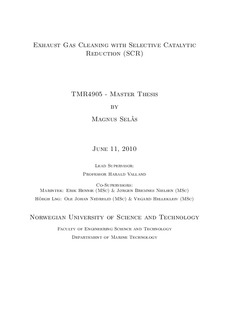| dc.contributor.author | Selås, Magnus | nb_NO |
| dc.date.accessioned | 2014-12-19T12:06:07Z | |
| dc.date.available | 2014-12-19T12:06:07Z | |
| dc.date.created | 2010-12-08 | nb_NO |
| dc.date.issued | 2010 | nb_NO |
| dc.identifier | 375407 | nb_NO |
| dc.identifier.uri | http://hdl.handle.net/11250/237821 | |
| dc.description.abstract | This thesis presents the work around three laboratory experiments conducted in the machinery laboratory at MARINTEK with focus on performance and degrading mechanisms of a Selective Catalytic Reduction system. Höegh LNG has contributed to the thesis from an industrial perspective together with various Norwegian shipping companies. An introduction to emissions from combustion engines is given, with focus of the real pollutants as NOx, SOx, CO, HC and PM. CO2 has not been defined as a real pollutant as it’s not itself toxic, but still is a major concern due to it’s contribution to the greenhouse effect. The real pollutants only represents about 0,6% of the total emissions from a combustion engine. An introduction to today’s and future emission limits has been presented.
The system consists of a catalyst that contains ceramic stones with a honeycomb shape. The honeycombs contain the active material that reacts with the NH3 introduced in the exhaust gas and reduce the NOx to N2 and H2O. The honeycombs may be coated with the active material or homogeneously extruded. The control unit controls the urea feed rate, and the urea react with water and together with the exhaust heat becomes NH3. The system efficiency is dependent on the ammonia feed rate and a 90 to 95% reduction of NOx is possible. Higher efficiency is possible, however with increased risk of NH3 slip.
Degrading mechanisms have been investigated with respect to fatigue and deposits. The SO2 to SO3 conversion rate sets the basis for formation of deposits, and hence should be reduced as much as possible. With respect to fatigue, we investigated with a laboratory experiment whether the temperature variations were sufficient to cause any thermal strain on the honeycombs. This hypothesis was undermined as the temperature variations logged were in the lower edge of 10oC.
Whether logging of temperatures can function as indicators of degrading of the catalyst were investigated in a second experiment. The approach was to search for a correlation between the temperature in the catalyst material (TCenter) and the catalyst activity as degrading of the lab catalyst require many hours of operation. We did not find a clear connection between the two, however a connection between the activity and temperature difference ΔT = T2 − T1 was discovered. This will be a topic for further investigation by MARINTEK.
The performance of the SCR in the machinery lab has been documented, with a reduction efficiency of 95% in compliance with international ammonia slip level requirement. A bleed of the turbocharger compressor was performed in order see if increased the exhaust gas temperature would increase the reduction efficiency. This was not the case as we achieved same reduction efficiency with somewhat higher slip. The increased NOx emission level has been corrected for. A FTIR gas analyzer was rented by MARINTEK in order to verify the accuracy of their Horiba PG-250. When comparing the two instruments, deviations were neglectable.
The number one challenge for SCR according to shipping companies is to ensure satisfying reduction efficiency when the engine is experiencing frequent load changes. Together with this the challenge is to get SCR working properly with low speed two stroke engines operating on HFO. | nb_NO |
| dc.language | eng | nb_NO |
| dc.publisher | Norges teknisk-naturvitenskapelige universitet, Fakultet for ingeniørvitenskap og teknologi, Institutt for marin teknikk | nb_NO |
| dc.title | Exhaust Gas Cleaning with Selective Catalytic Reduction (SCR) | nb_NO |
| dc.title.alternative | Rensing av eksosgass med Selektiv Katalytisk Reduksjon | nb_NO |
| dc.type | Master thesis | nb_NO |
| dc.contributor.department | Norges teknisk-naturvitenskapelige universitet, Fakultet for ingeniørvitenskap og teknologi, Institutt for marin teknikk | nb_NO |
